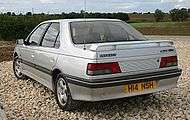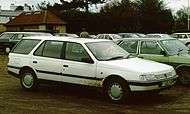Peugeot 405
| Peugeot 405 | |
|---|---|
 | |
| Overview | |
| Manufacturer | Peugeot |
| Production |
1987–1997 (Europe) 1987–present (Iran/Egypt) |
| Assembly |
Argentina by (Sevel) (1992–2000) Chile, by Franco Chilena Egypt, by Iran Khodro (2006–present) AAV (1992–20??) France (1987-97) Indonesia, by Gaya (1989–1997) Iran, by Iran Khodro (1992–present) Malaysia, by OASB [1] Poland, by FSC (1993–1995) Taiwan, by Yu-Tien (1989–1995) United Kingdom (1987–1997) Zimbabwe, by Quest (1987–2002) |
| Designer | Pininfarina |
| Body and chassis | |
| Class | Large family car |
| Body style |
4-door saloon 5-door estate |
| Layout | Front engine, Front-wheel drive / Four-wheel drive |
| Related |
Citroën BX IKCO Samand, Peugeot Pars, IKCO Dena, Peugeot RD |
| Powertrain | |
| Engine | Inline-4, 1.4-2.0 L, petrol/diesel |
| Dimensions | |
| Wheelbase | 2,669 mm (105.1 in) |
| Length | 4,408 mm (173.5 in) (sedan) |
| Width | 1,716 mm (67.6 in) (sedan) |
| Height | 1,390 mm (55 in)-1,450 mm (57 in) |
| Curb weight | 1,020 kg (2,250 lb)-1,430 kg (3,150 lb) |
| Chronology | |
| Successor | Peugeot 406 |
The Peugeot 405 is a large family car released by the French automaker Peugeot in July 1987, and which continues to be manufactured under licence outside France. It was voted European Car of the Year for 1988 by the largest number of votes in the history of the contest.[2] About 2.5 million vehicles have been sold worldwide, both in LHD & RHD, as a sedan and station wagon.
Its appearance is similar to the Alfa Romeo 164, launched the same year and also styled by Pininfarina. While the 405 shares its bottom plate with the Citroën BX, it does not have that car's hydropneumatic suspension.[3] As with the BX, the 405 used TU/XU petrol and XUD diesel engines.
The 405 was the last Peugeot vehicle sold in the United States, on sale between 1988 and 1991, including the Mi16.[4]
History
The 405 has been available in LHD, and RHD versions, as a saloon and estate, in front-wheel, and four-wheel drive. No coupé was ever offered to the public, unlike the 504 and later 406, as only two examples of the purpose-built 405 Turbo-16 (not to be confused with 405 T16) were made. The 405 was first introduced in July 1987 for the 1988 model year, with Peugeot unveiling 10 versions of the 405 simultaneously. European mainland sales began before Christmas. The 405 was originally available as a four-door only. Four-cylinder petrol engines ranging from 65 to 160 PS (48 to 118 kW) were available. In 1988 naturally aspirated and turbocharged diesel engines were added to the range. An Estate model was also introduced. Sales in the United Kingdom began in January 1988.[5] By 1989 500,000 vehicles had been produced, followed by the one millionth 405 to leave the Sochaux factory in 1990. This was also when the BE1 transmission was replaced by the BE3.
In 1991 there were updates to the dashboard, steering wheel, and soundproofing, but for 1993 the Phase 2 model arrived with a new boot (trunk) with better ingress, new rear lights and boot design and a new dashboard. 405 production had reached over 1.5 million by this time.[6]In 1995 the 405's replacement, the 406 was introduced and the 405 saloon discontinued. Airbag had earlier become an option on some models, and standard on the left-hand-drive Mi16 and T16. In 1997 the estate model was discontinued in Europe, marking the end of European production of the 405.
Manufacturing
The 405 has been manufactured in a number of world-wide locations. Designed in France, it has been manufactured in:
- Europe: from 1987 to 1997 at Sochaux (France) and Ryton (United Kingdom).
- Zimbabwe: until 2002, by Quest.
- Egypt: Wagih Abaza produced the 405.
- Iran: produced by Iran Khodro since mid-1990.
- Chile: Produced by Franco-Chilena in Los Andes, including STI Phase II model.
- Argentina: Several saloon models, including diesels were built in the Villa Bosch Peugeot facility from 1992 to 1999. In this country the 405 has been an extremely popular car, with total sales of over 500,000 units.
- Poland: Around 4000 were assembled in FSC Lublin between 1993 and 1995.
- Taiwan: Produced by Yu-Tien Motors from 1989 until 1995 (Production ceased after bankruptcy).
Models
The 405 range included three petrol engines and two diesel engines, all four-cylinders, in a variety of states of tune and specification. The range was tailored to suit different export markets. The 1.6-litre saloon featured a low drag co-efficient of Cd=0.29, with other models varying up to Cd=0.33. The 1.4-litre (1360 cc) engine was fitted with a four-speed manual gearbox. It produced 70 hp (52 kW) at 5600 rpm. The 1.6-litre (1580 cc) engine was fitted with a five-speed manual gearbox and produced 92 hp (69 kW) at 6000 rpm. The 1.9-litre (1905 cc) engine was available with a five speed manual gearbox, with an option of an automatic in the lower powered version.
The eight-valve version of the engine was available in two levels of tune; 110 hp (82 kW) or 125 hp (93 kW). A 16-valve version was available with the Mi16 model and this produced 160 hp (120 kW) at 6500 rpm and could reach a top speed of 220 km/h.[7] In 1992 the range was facelifted. While the changes were deep, including a modified bottom plate and chassis structure, the design was almost indistinguishable from the pre-facelift model. The windscreens were now bonded; all of these changes increased torsional rigidity considerably while still allowing a deeper opening for the bootlid of the sedan.[8] The taillights were also redesigned and the trim piece between them removed, all in the image of the bigger 605. The interior was also redone, with an all-new dashboard and door trim, inheriting lots of detail parts as well as the overall appearance from the 605.[8]

In 1993, the T16 homologation special was introduced with a 2.0-litre 16-valve turbocharged XU10J4TE engine with water-cooled chargecooler, constant four-wheel drive with 53/47% power distribution and self-regulating hydraulic rear axle. It was never built in a right-hand-drive model. The T16 produced 200 hp (150 kW) at 1.1 bar (16 psi) (normal boost) 220 hp at 1.3 bar (19 psi) (overboost) for 45 seconds. 1061 examples were built, 60 of them for the French Police.[9]
The diesel options included a 1.9-litre (1905 cc) producing 70 bhp (52 kW) at 4600 rpm or a turbocharged 1.8-litre (1769 cc) producing 90 bhp (67 kW)
British models
1988–1992 range
- GE - 1.6 L 8-valve, basic model (Style in United Kingdom)
- GL/GR - 1.6L 8-valve, 1.9L 8-valve
- GLD/GRD - 1.9L 8-valve diesel
- GLDt/GRDt/GTDt 1.8L 8-valve turbo diesel
- GRi/SRi/GTX - 1.9 L 125 bhp 8-valve fuel injected, based on the same engine as the 205 GTI 1.9.
- Mi16 - 1.9L 16-valve fuel injected all alloy engine, with 160 bhp (119 kW; 162 PS). The engine (XU9J4) of the Mi16 was later used by Peugeot as the basis for the engine in the 206 WRC, winning two championships.
- Mi16x4 - Another version with the 1.9L 16-valve Mi16 engine, albeit with a slightly higher engine rpm limit than the 2wd model - although no extra power - but featuring permanent 4 wheel drive, and a self-levelling hydroelastic rear suspension system.
1992–1994 range
- Style - 1.4 L 8-valve, 1.6L 8-valve, 1.9 L 8-valve diesel
- GL/GLdt - 1.4 L 8-valve, 1.6L 8-valve, 1.8L 8-valve, 1.9 L 8-valve diesel, 1.9 L 8-valve turbo diesel
- GR/GRdt - 1.6 L 8-valve, 1.8L 8-valve, 2.0L 8-valve, 1.9 L 8-valve diesel, 1.9 L 8-valve turbo diesel
- SRi/SRdt - 2.0 L 8-valve, 1.9 L 8-valve inter-cooled turbo diesel, with rear spoiler and sports styling
- STi/STdt - 2.0 L 8-valve, luxury model, 1.9 L 8-valve turbo diesel
- Hunter - 1.9 L 8-valve turbo diesel, Special edition
- Mi16 - 2.0 L 16-valve, 155 bhp (116 kW; 157 PS)
- Mi16 Le Mans - 2.0 L 16-valve, Special edition Mi16, came with special edition red paint, alcantara (leather/suede) seats and alloys. 1,000 produced
1994–1996 range
- Style - 1.6L 8-valve, 1.9 L 8-valve diesel, 1.9 L 8-valve turbo diesel
- Quasar - 1.8L 8-valve, 1.9 L 8-valve diesel, 1.9L 8-valve turbo diesel
- GLX - 1.6L 8-valve, 1.8L 8-valve, 1.9 8-valve diesel, 1.9 8-valve turbo diesel
- GTX - 2.0L 8-valve, 1.9 8-valve diesel, 1.9 8-valve turbo diesel
- Executive - 2.0L 8-valve, 1.9 8-valve turbo diesel
- Caddywagon
1996–1997 range (estate models only)
- Style - 1.8L 8-valve, 1.9L 8-valve diesel, 1.9L 8-valve turbo diesel
- LX - 1.8L 8-valve, 1.9L 8-valve diesel, 1.9L 8-valve turbo diesel
- GLX - 2.0L 8-valve, 1.9L 8-valve turbo diesel
- Executive - 2.0L 8-valve, 1.9L 8-valve turbo diesel
North American models

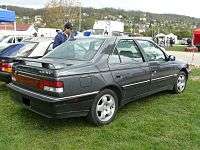
Three versions of the 405 saloon were sold in North America from the end of 1988; the 1.9 (110 hp (82 kW)) DL and S, and the Mi16 (150 hp (110 kW)).[10] The DL and S were available in estate form called Sportswagen.[11]
Iranian models
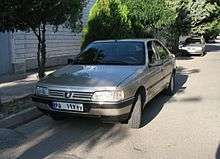
Iran Khodro also produces several models derived from the 405. The Peugeot Pars, also known as the Peugeot Persia, is a facelifted 405 with a redesigned front end including clear lamp lenses and a revised rear. The Peugeot RD is a rear wheel drive car which has a 405 body and mechanical parts from the Paykan.[12] Since 2006, it has been sold in certain Middle Eastern markets as the Peugeot ROA.[13]
The Samand, which was designed to be a "national car" for Iran, is also based on the 405 platform. It replaced the long-running Paykan which was itself based on the Hillman Hunter, an ancestor (in corporate ownership and model positioning terms) of the 405, having been produced by the Rootes Group and Chrysler UK from 1963 until 1979 - the year that Peugeot purchased Chrysler's European operations.
Iran Khodro, the leading Iranian car manufacter produces the following models of Peugeot 405:
- Peugeot 405 GL/GLX with 2.0L 8-valve engine, this model's production stopped in 2002.
- Peugeot 405 GLX with 1.8L 8-valve engine and modified options.
- Peugeot 405 SLX with 1.6L 16-valve PSA TU5 engine, New designed dashboard, two airbags.
- Peugeot Pars: A modern facelift of the 405 in four models with 1.8L 8-valve, 2.0L 8-valve, 1.6L 16-valve (PSA TU5 engine) and 1.8L 16-valve engines. Some variants of this model has new options like airbags.
- Peugeot RD and Peugeot ROA: Cheaper models with the 405 body and 1.6L 8-valve Peykan engine. The production of these models was stopped in 2011.
Motorsport

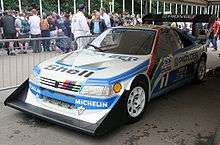
The motorsport version of the 405, the rallying 405 Turbo 16 GR, was very different from the road-going 405. It was built in a coupé body style in mid-engine configuration, had constant four wheel drive with electronically adjustable center differential like the 205 T16, as it was based on the same technology. At least four were produced, competing in hill climbs and the Paris-Dakar rally. Today, three are in the official Peugeot museum, and the other is in a private collection.
- 1988: Finnish driver Ari Vatanen set a new record in the Pikes Peak International Hillclimb (an award winning film of the drive titled Climb Dance was made by Jean Louis Mourey). Kankkunen and Piironen win the Paris-Dakar Rally in the 405 T16 GR.
- 1989: Victory in the Paris-Dakar rally by the Vatanen-Ickx team in a 405 T16 GR.
- 1990: Victory in the Paris-Dakar rally by the Vatanen-Berglund team in a 405 T16 GR.
Racing 405s much closer in specification to the road-going models were campaigned for several years in European touring car racing during the early to mid 1990s, most notably in the British Touring Car Championship and the French Supertourisme Championship. In Britain, the 405 did not achieve much success, but the car won the French series in both 1994 & 1995, in the hands of Laurent Aïello.
Gallery
|
Sales and production
| Year | Worldwide Production | Worldwide sales | Notes |
| 2009 | 220,300[14] | 234,700[14] | |
| 2010 | 302,200[14] | 299,400[14] | |
| 2011 | 282,399[15] | 270,551[15] | Total production reaches 4,518,350 units.[15] |
| 2012 | 108,400[16] | 110,600[16] | Total production reaches 4,626,700 units.[16] |
Notes
- ↑ Leeps (1989-06-04). "Rust Busters". New Straits Times / Google News Archive. Retrieved 2015-05-03.
- ↑ "Rewind to 1988: Peugeot 405.". Quicks. Retrieved 23 January 2014.
- ↑ Geogheghan, Simon (2013). "Citroen BX". Simon Cars. Retrieved 2016-08-21.
- ↑ Cammisa, Jason (October 2011). "Collectible Classic: 1989-1991 Peugeot 405Mi16". Automobile. Retrieved 13 August 2012.
- ↑ Finlay, Ross (1988-01-22). "Company firing on all cylinders". The Glasgow Herald. Retrieved 2016-08-19.
- ↑ Anderson, Donn, ed. (April 1993). "Under the skin". New Zealand Car. Auckland, New Zealand: Accent Publishing Cnr. 7 (6): 85. ISSN 0113-0196.
- ↑ l'Auto-Journal Salon 91-92, number 14/15, p. 56
- 1 2 Under the skin, p. 82
- ↑ "Peugeot 405 Profile". Rellye-Info.com. Retrieved 2016-08-19.
- ↑ "Peugeot 405 Mi 16: A Slick and Powerful Sleeper". Record-Journal. 3 November 1990. Retrieved 29 August 2012.
- ↑ "Wagon Lode". Popular Mechanics. June 1989. Retrieved 29 August 2012.
- ↑ "Peugeot RD". ikco.com. Retrieved 2007-06-19.
- ↑ "Oriente Medio: Peugeot resucita al 405". es.autoblog.com (in Spanish). Retrieved 2007-06-19.
- 1 2 3 4 "Engine specs from PSA Peugeot Citroën" (PDF). Creator and designer. PSA Peugeot Citroën. Retrieved 26 November 2012.
- 1 2 3 "PSA Annual Report 2012" (PDF). Car manufacturers. PSA. Retrieved 5 April 2013.
- 1 2 3 "Memento Mars 2013" (in French). PSA Peugeot Citroën. 21 February 2013: 50. Retrieved 31 July 2013.
www.scai.industry.gov.iq/index.php
External links
| Wikimedia Commons has media related to Peugeot 405. |
- Climb Dance short film at Google Video
- Climb Dance short film in higher quality, 61MB MPEG file
- A British TV ad featuring the song Take My Breath Away
| « previous — Peugeot, a marque of Groupe PSA since 1976, car and LCV timeline, 1980s–present | |||||||||||||||||||||||||||||||||||||
|---|---|---|---|---|---|---|---|---|---|---|---|---|---|---|---|---|---|---|---|---|---|---|---|---|---|---|---|---|---|---|---|---|---|---|---|---|---|
| Type | 1980s | 1990s | 2000s | 2010s | |||||||||||||||||||||||||||||||||
| 0 | 1 | 2 | 3 | 4 | 5 | 6 | 7 | 8 | 9 | 0 | 1 | 2 | 3 | 4 | 5 | 6 | 7 | 8 | 9 | 0 | 1 | 2 | 3 | 4 | 5 | 6 | 7 | 8 | 9 | 0 | 1 | 2 | 3 | 4 | 5 | 6 | |
| City car | iOn | ||||||||||||||||||||||||||||||||||||
| 107 | 108 | ||||||||||||||||||||||||||||||||||||
| Supermini | 104 | 106 | 207 | 208 | |||||||||||||||||||||||||||||||||
| 205 | 206 | 206+ | |||||||||||||||||||||||||||||||||||
| Small family car | 305 | 301 | |||||||||||||||||||||||||||||||||||
| 309 | 306 | 308 | 308 | ||||||||||||||||||||||||||||||||||
| 307 | 408 | ||||||||||||||||||||||||||||||||||||
| Large family car | 504 | 405 | 406 | 407 | 508 | ||||||||||||||||||||||||||||||||
| 505 | |||||||||||||||||||||||||||||||||||||
| Executive car | 604 | 605 | 607 | ||||||||||||||||||||||||||||||||||
| Coupé | 406 Coupé | 407 Coupé | |||||||||||||||||||||||||||||||||||
| RCZ | |||||||||||||||||||||||||||||||||||||
| Convertible | 205 Cabriolet | 206 CC | 207 CC | ||||||||||||||||||||||||||||||||||
| 306 Cabriolet | 307 CC | 308 CC | |||||||||||||||||||||||||||||||||||
| Mini MPV | 1007 | ||||||||||||||||||||||||||||||||||||
| Compact MPV | 5008 | ||||||||||||||||||||||||||||||||||||
| Large MPV | 806 | 807 | |||||||||||||||||||||||||||||||||||
| Crossover | 2008 | ||||||||||||||||||||||||||||||||||||
| 3008 | |||||||||||||||||||||||||||||||||||||
| SUV | 4007 | 4008 | |||||||||||||||||||||||||||||||||||
| LAV | Bipper | ||||||||||||||||||||||||||||||||||||
| Partner | Partner | ||||||||||||||||||||||||||||||||||||
| LCV | J5 | Expert | Expert | Traveller | |||||||||||||||||||||||||||||||||
| J7 | J9 | Boxer | Boxer | ||||||||||||||||||||||||||||||||||

